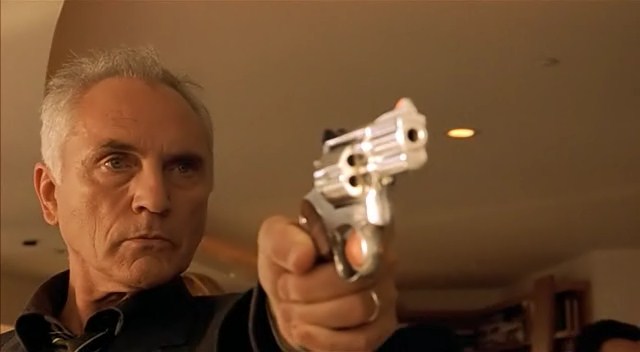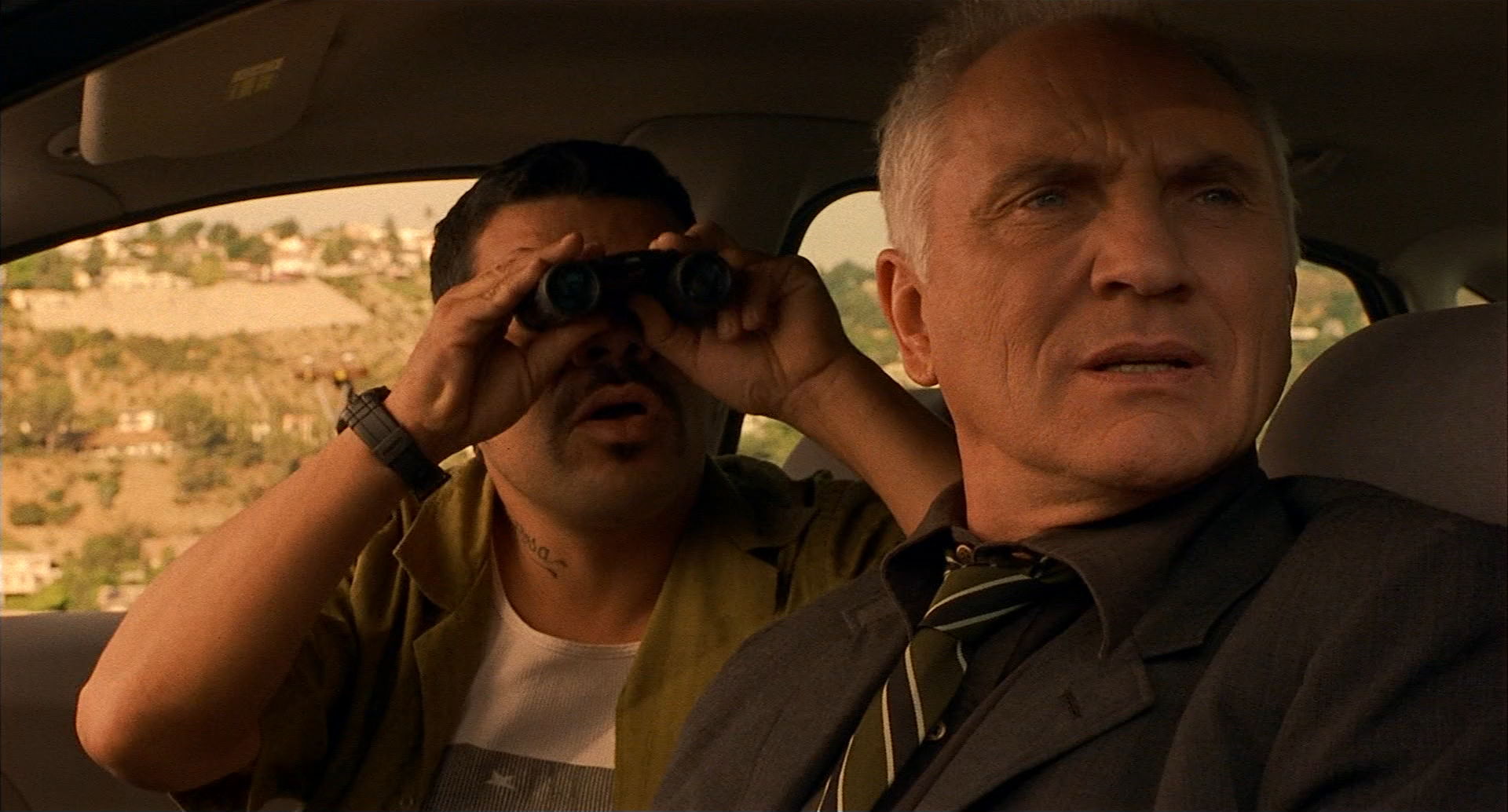
“I respect my audience, and I assume they come to the theatre with a certain level of intelligence, but I don’t pander to them. I feel like, ‘Look, I’m going to take you somewhere, you can go or not go, but here is where we’re going’. I like that attitude when I see movies.”
– Steven Soderbergh
The stars my destination
“Tell me,” intones a deeply troubled Cockney voice amidst the sound of crashing waves. “Tell me,” the voice repeats, sounding increasingly anxious, “Tell me about Jenny,” anger edging into his insistence and all this before the picture has taken a first step.
The growly voice belongs to Wilson (a superb Terence Stamp), and his insistence isn’t just for chapter and verse about Jenny, his daughter, recently killed in a suspicious car crash, but for a clear perception of the young woman he hasn’t seen for nearly a decade. Wilson, the eponymous limey, and taciturn tough guy, has just been released from prison across the pond, now in LA, he’s out to get to the bottom of Jenny’s ruin, and hell has come with him.
Always imaginative and forever fragmented, 1999’s The Limey is a frequently funny, and repeatedly poignant revenge thriller from director Steven Soderbergh (Traffic, Ocean’s Eleven) and screenwriter Lem Dobbs. Soderbergh and Dobbs, it’s worth noting, worked together previously on the film Kafka (1991) and then again on Haywire (2012). Soderbergh is playful yet poisonous with the narrative, which he famously tagged “Resnais making Get Carter.”
“Soderbergh’s style evokes the memory of John Boorman’s Point Blank, which in its time was misunderstood because of its similarly complex narrative style and which also dealt with revenge taken by a determined loner.”
– epd Film
Revenge proves its own executioner

Stamp’s as Wilson, an ageing ex-con with a proclivity for Cockney rhyming slang, gads betwixt three distinct timelines, confirming the director’s Resnais reflection (think Hiroshima, Mon Amour or Last Year at Marienbad): we see the limey as a young man, his daughter but a girl, their relationship sunlit, domestic, and unassailable; Wilson as resilient strong-arm initiating his investigation and readying for oozing bad blood and ill will; and also we find him repeatedly in quiet requiescence after all the blood and thunder has come and gone.
For the young Wilson chronology, Soderbergh and his extraordinary editor Sarah Flack have resourcefully and with prudence, reappointed footage of Stamp from English director Ken Loach’s debut film from 1967, Poor Cow. It’s an astonishing reappropriation, and one that feels, for all intents and purposes like a sleight of hand act of sorcery each time the trick is performed.
“Point Blank is one of my favorite movies, so when Steven told me, ‘I’m gonna make a kind of Point Blank,’ I was in heaven. I figured what made Lee Marvin so ominous was that his lowest tension was his highest intensity. So I thought, that’s how Wilson has to be. He has to be totally relaxed and totally coiled all the time.”
– Terence Stamp
To live and die in L.A.

Once in Los Angeles, Wilson befriends Eduardo and Elaine (Luis Guzmán and Lesley Ann Warren, both excellent), film industry friends of Jenny’s, both troubled by her suspicious death and enamoured, somewhat, by Wilson.
Wilson’s alliance with Eduardo and Elaine allows for some requisite discourse on Tinseltown as well as playing up the fish-out-of-water elements to the story. Sure, it is all rather conventional, to a point, but Soderbergh and Dobbs have a more existential agenda and soon the looming shadow of Peter Fonda’s dubious rock impresario, Terry Valentine, makes for the most likeliest of suspects. As far as villains go, he’s sympathetic straight away, and as amiable as Wilson is no-nonsense.
“A revenge thriller told as an acid flashback, The Limey slips between time frames and points of view, mingling its onscreen story with its actors’ histories: Terence Stamp and Peter Fonda—cannily cast as a sleazy counter cultural entrepreneur—are riffing on their screen personae as much as they’re playing roles, although Soderbergh and writer Lem Dobbs keep their cinematic reference points below the surface.”
– The A.V. Club
We should forgive our enemies, but not before they are hanged

For all its noodling and posturing The Limey gleefully behaves as a satiating smorgasbord for both art film fans and noir aficionados. The Cliff Martinez soundtrack sweetens the pot, combining with cinematographer Edward Lachman’s visuals that offer a vibrant snap and a lot of gloriously vibrant Nouvelle Vague vitality.
When Wilson snaps, his anger and repayment becomes a tit for tat display of savagery, and The Limey takes many left field deflections rare to the genre. One top-drawer sequence with a stationary camera, has Wilson, ejected from a warehouse by thugs (real slimeballs who, after beating Wilson, insult both him, and his daughter’s memory), marching right back to them, but the camera is at such a distance that we can barely see what transpires apart from the muzzle flashes of his gun.
Most of what goes on is out of frame, though the sound of gunfire and the screams of men deepen the sense of dread. The result is electric, and the blood-splashed face of Wilson as he returns, howling threats, comes across flush, popping and exploding like fireworks. When I saw this sequence in the theatre I was overcome, stars in my eyes, instantly I connected it to a famous scene with James Cagney in William A. Wellman’s gangster epic from 1931, The Public Enemy, and every bit as powerful.
With The Limey, Soderbergh certainly spoils for the ashen shock of pulp and regularly outstrips them. With a tragic sense of corollary in a Möbius strip morass, Soderbergh lands us in familiar cinematic ground but with astonishing and unexpected upheavals and pathos.
“Tell me…
“Tell me…
“Tell me about Jenny.”
– Wilson (played by Terrence Stamp)
Author Bio: Shane Scott-Travis is a film critic, screenwriter, comic book author/illustrator and cineaste. Currently residing in Vancouver, Canada, Shane can often be found at the cinema, the dog park, or off in a corner someplace, paraphrasing Groucho Marx. Follow Shane on Twitter @ShaneScottravis.